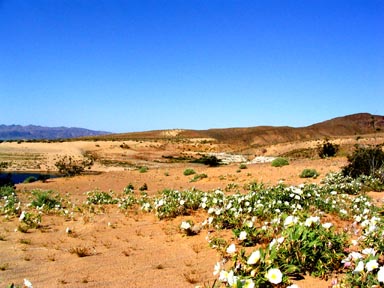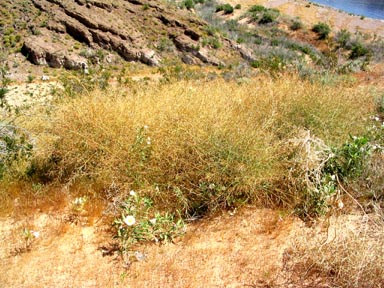2005 SOUTHWEST Desert Exotic Mustard Survey
Reports from Lake
Mead National Recreation Area
- April 2005
Photos and text
by Elizabeth Ann (Libby) Powell, Ph.D., Botanist,
while working to manage the Saharan mustard infestations
at the Lake Mead National Recreation Area.
Office: 601 Nevada Highway, Boulder
City, NV 89005

How the dunes should look at Lake Mead

When the dunes start to get Sahara Mustard

When the Sahara mustard is solid
EXOTIC MUSTARDS REPORT from LAKE MEAD,
April 14, 2005:
[Sisymbrium] S. irio- was very much more common at Lake Mead NRA
this year than we have ever seen it before. It appears to be along
roadsides, where water has pooled, but was in dense stands in
those areas.
We did not like what we saw this year with this plant. We also
did not like seeing so much African Malcolmia-another mustard-
that was everywhere- particularly on gypsum, this year. It is
very possible that while our attention is focused on Sahara mustard,
we will find out that Sisymbrium or another species has moved
in. We can't put blinders on - we need to be aware that all these
alien species are potential threats.
There is no need to nit pick details
on Sahara mustard- we have a disaster on our hands that a great
deal of manpower will be needed- just to keep at bay.
Plants disperse by several mechanisms- large plants act as tumbleweeds
and roll across the landscape shedding seeds that pop forcefully
out of the pods.
Plants can float in water for a long timeand still have viable
seeds on them- we tested seed that had been under water in Lake
Mead for up to 11 weeks and they still germinated.
Rodents cache the seed and move seed into open desert, and frequently
to caches under shrubs where their burrows are, at some distance
from original infestation, almost immediately.
These seeds are oil rich and tasty and my guess is that they are
a favorite of all seed eating animals.
Seeds have a mucilaginous coat then swells up and adheres to almost
anything within a few seconds of being in contact with water.
I suspect that plants are moved by vehicles, earth moving equipment,
people, animals, wind, and water.
Plants can roll down roads, float across lakes, be cached and
recached by animals that move the seeds up to 100 meters from
the last cache. Cached seeds can germinate and go to fruit just
fine-even in dense competition with other seedlings in the same
cache.
I suspect that Sahara mustard has
gotten started along roads, either by earthmoving equipment, road
grooming equipment, vehicles, or because roads are corridors.
Once on the road side- seeds are cached by animals into open desert
under shrubs, or plants tumble into open desert and get caught
in shrubs, or both.
When populations saturate all the rodents in neighborhood, plants
spread out into the open desert. We have observed this at Lake
Mead NRA. We found Sahara mustard along the road, and particularly
at corners, on Christmas Tree Pass in the Newberry Mountains.
We were particularly puzzled by how disjunct the populations were.
After talking with Maintenance people, we found out that road
repairs were made with fill from a highly infested area and road
grading probably explained the spread along the road and particularly
at corners, where soil tends to be piled up. Soft soil piles are
good places for rodent caches, as well.
We were able to stop the infestation from further spread by pulling
out all the plants along the roadsides and from infected places
before they went to fruit, but we have had to do this religiously
and thoroughly for 2 years in a row, so far. This means that there
is a seed bank of unknown longevity that may haunt us for years
to come.
I think Sahara mustard has a preference
for sand and gravels- but we have found it on heavy gypsum- and
in very salty soils, like under established saltcedar stands-
It is mistake to think this plant only is a menace for sandy soils.
- It goes to sand first- but it goes everywhere else, as well.
Seeds can germinate in water laced with high concentrations of
salt.
On Sandy Cove, a dune system here
at Lake Mead NRA that is home to the largest known population
of a rare plant, we have been removing plants with ever increasing
intensity for 5 years now. When the water was high in 2000, there
were very few Sahara mustard plants on the dunes. When the water
went down we started seeing infestations in the drawdown zone.
These infestations have now gotten so huge, we can't deal with
them all. Plants get huge along the shoreline where there is ample
water and these huge ball-like plants, break off and the plants
blow up onto the dunes. A great deal of the shoreline is now infested
and plants have moved up out of the drawdown zone into open desert.
We can't stop it.
On the east side of the dunes, I found NO Sahara mustard plants
in 2001, in 2003, I pulled
out less than 50 plants from the dunes while I was doing my rare
plant survey. In 2004, we pulled out over 3,000 plants from that
same area. This year we pulled out over 10 times that from the
same area, and had to leave large sections that were too steep
for us to get down on to pull out the plants. I think this plants
can and does explode, maybe we don't know exactly
how, but it does it.
Seed production is huge, viability
is very high, and there may not be as much predation as we would
like. The rate of growth may be uneven and extremely large in
certain years- also the seedbank itself works against us.
We also are doing roadside surveys
for invasive species of plants, including Sahara mustard- it costs
a lot to do these surveys-the labor, data management, vehicles,
etc. However, I feel that if we waste valuable time that this
plant does not afford us, by studying how bad it is- we may miss
the window we need to actually do something about it before it
is so widespread, there is nothing we can do- but wring our hands
because now we know how bad it is.
We have sites on Lake Mead that we
have been clearing of Sahara mustard for the last few years, that
were so covered with plants this year, and our manpower priorities
so critical, and time so short, that we could not do anything
this year. We had to watch helplessly while these areas get reinfested
with another huge seed crop that will haunt us for the next- who
know- 6 years?? And spread even further into the desert and up
washes- making control ever more impossible.
It is time to act, not study this menace- in my opinion- or say
goodbye
to our favorite desert places as we have known them. It is definitely
easier and more fun to create experiments rather than start pulling
plants- but pull we better start doing- soon- or we can forget
finding an answer otherwise, in my opinion.
When areas get completely overwhelmed,
we will need to basically nuke the whole area with herbicide and
start over-because Sahara mustard it is not going away- it is
spreading rapidly and populations are becoming denser and more
pernicious every year- that is what I am seeing here at Lake Mead,
in any case.
There are miles upon miles of Sahara
mustard infestations on Mormon Mesa, in Logandale, and along the
highway to Mesquite, my surveyors tell me- you don't have to go
to California to find huge overwhelming fields of this stuff.
There are collections of Brassica
tournefortii from Lake Mead in the 1970's, we just recently figured
out we had a problem when plants showed up on Sandy Cove and in
other places around the park that are particularly sensitive habitats.
These pictures were taken on Sandy
Cove.
<><><><><><><><><><><><><><><>
UPDATE April 19, 2005
IS THE CLARK COUNTY (Las Vegas) Multiple
Species Habitat Conservation Plan in trouble from the Saharan
Mustard?
I think the Clark County MSHCP is
in trouble for keeping a permit for Astragalus geyeri- because
they cannot claim they have this plant is "covered"
- that is able to continue developing without that plant becoming
endangered- by any stretch of the imagination.
Astragalus geyeri is a very rare sand-
loving annual- the habitat for which has been swamped by Sahara
mustard this year. My guess is that a study will ensue that will
tie up resources and
people for several years while they try to figure out how much
of a threat Sahara mustard really is. If the weather turns dry
for the next few years- then it shows there wasn't much of a problem.
<><><><><><><><><><><><><><><>
UPDATE April 20, 2005
COST of REMOVAL of SAHARA MUSTARD
I calculated what it approximately
cost us in labor only to remove the 270,000 plants from the 157
acres [1,720/acre] of Sandy Cove that we did this year at Lake
Mead NRA.
I calculated $197 per acre [11 cents
per plant]. I calculated this by adding up all the man hours spent
this year on Sandy Cove only and dividing by the number of acres
of the dune site and multiplying that number by the average salary
of the crew by averaging the per hour cost to Lake Mead NRA for
highest to lowest paid.
I did not attempt to figure out what
it cost for use of the boat and cost of equipment, bags, etc.
Therefore, this is a conservative estimate of the true cost to
remove Sahara Mustard from this
one dune system.
UPDATE AUGUST 10, 2005 --
see Chart of Saharan mustard trends:
"Potential Grow of Brassica
per Acre with different scenarios"
Back to main mustards
web page - Updated April 4, 2016.
Updated December 24, 2022 - The Reveg
Edge Ecological Restoration service